spare wheel AUDI S8 2016 Owners Manual
[x] Cancel search | Manufacturer: AUDI, Model Year: 2016, Model line: S8, Model: AUDI S8 2016Pages: 302, PDF Size: 75.68 MB
Page 245 of 302
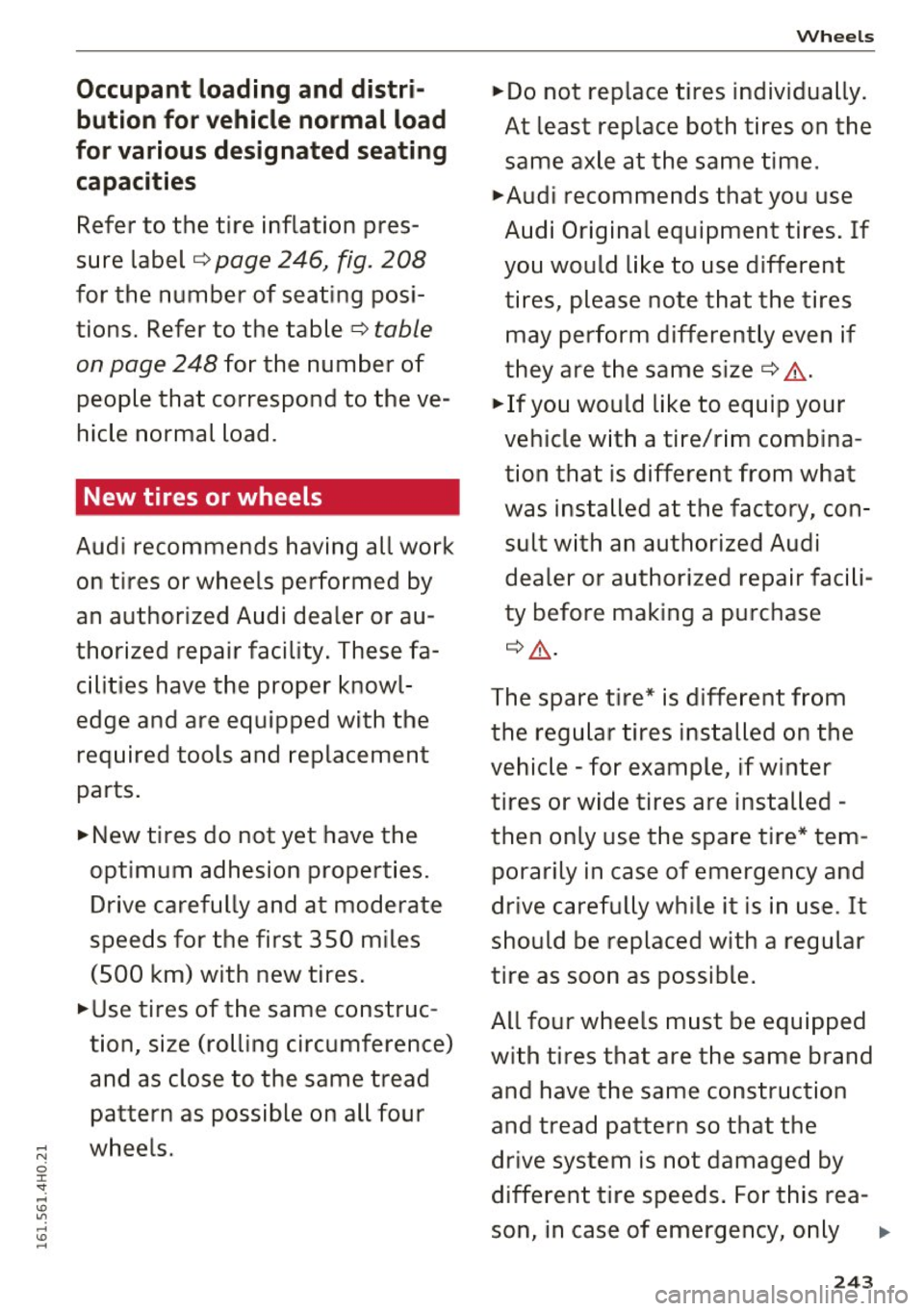
Occupant loading and distriĀ
but ion for vehicle normal load
for various design ated se ating
c a pa cit ies
Refer to the tire inflation presĀ
sure label Ā¢
page 246, fig. 208
for the number of seating posiĀ
tions. Refer to the table Ā¢
table
on page 248
for the number of
people that correspond to the veĀ
hicle normal load.
New tires or wheels
Audi recommends having all work
on tires or wheels performed by
an authorized Audi dealer or auĀ
thorized repair facility. These fa Ā
cilities have the proper knowl Ā
edge and are equipped with the
required tools and replacement
parts .
.,,. New tires do not yet have the
opt imum adhesion properties.
Drive carefully and at moderate
speeds for the first 350 m iles
(500 km) with new tires .
... use tires of the same construcĀ
tion, size (rolling circumference)
and as close to the same tread pattern as possible on all four
;:::; wheels.
ci :c ": ....
'Ā° V, ....
'Ā° ....
Wheels
.,,.Do not replace tires individually.
At least replace both tires on the same axle at the same time.
.,,. Audi recommends that you use
Audi Original equipment tires. If
you would like to use different
tires, please note that the tires may perform differently even if
they are the same sizeĀ¢,&..
.,,. If you would like to equip your
vehicle w ith a tire/r im combinaĀ
tion that is different from what
was installed at the factory, con Ā
sult w ith an authorized Audi
dealer or authorized repair faciliĀ
ty before making a purchase
~ .&. -
The spare tire* is diffe rent from
the regular tires installed on the
vehicle - for example, if winter
tires or wide tires are installed -
then only use the spare tire* temĀ
porarily in case of emergency and
drive carefully while it is in use . It
should be replaced with a regular
tire as soon as possible.
All four whee ls must be equipped
with tires that are the same brand
and have the same construction
and tread pattern so that the
drive system is not damaged by different tire speeds. For this rea-
son , in case of emergency, only .,.
24 3
Page 246 of 302
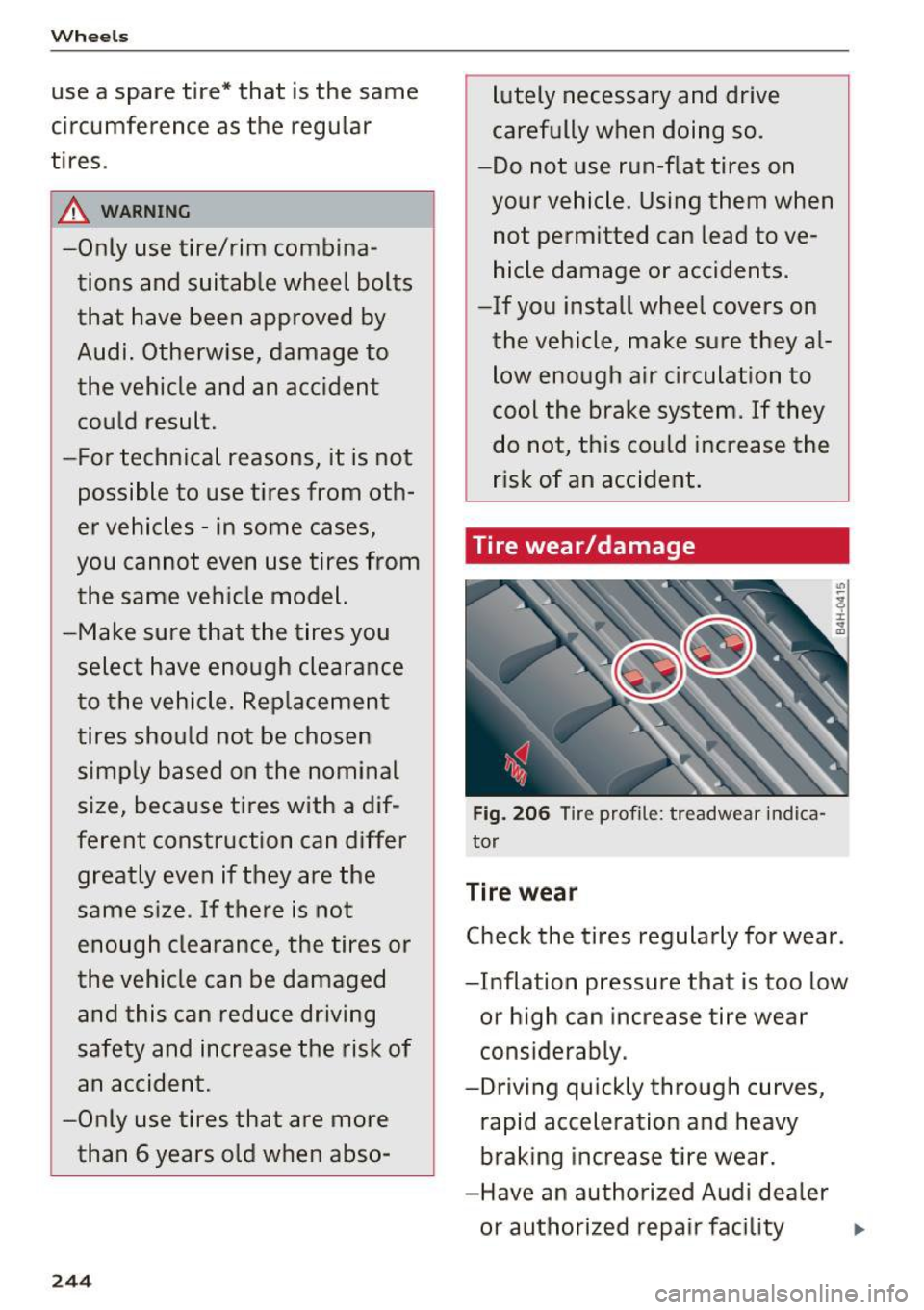
Wheels
use a spare tire* that is the same
circumference as the regular
tires .
A WARNING
-Only use tire/rim combinaĀ
tions and suitable wheel bolts
that have been approved by
Audi. Otherwise, damage to
the vehicle and an accident
could result.
-For technical reasons, it is not
possible to use tires from othĀ
er vehicles -in some cases,
you cannot even use tires from the same vehicle model.
-Make sure that the tires you select have enough clearance
to the vehicle. Replacement
tires should not be chosen
simply based on the nominal
size, because tires with a difĀ
ferent construction can differ
greatly even if they are the
same size. If there is not
enough clearance, the tires or
the vehicle can be damaged and this can reduce driving
safety and increase the risk of an accident.
-Only use tires that are more than 6 years old when abso-
244
lutely necessary and drive
carefully when doing so.
-Do not use run-flat tires on
your vehicle. Using them when not permitted can lead to veĀ
hicle damage or accidents.
-If you install wheel covers on
the vehicle, make sure they alĀ
low enough air circulation to
cool the brake system. If they
do not, this could increase the
risk of an accident.
Tire wear/damage
Fig. 206 Tire profile: treadwear indicaĀ
tor
Tire wear
Check the tires regularly for wear.
-Inflation pressure that is too low or high can increase tire wear
considerably.
-Driving quickly through curves, rapid acceleration and heavy
braking increase tire wear.
-Have an authorized Audi dealer or authorized repair facility
i.
Page 248 of 302
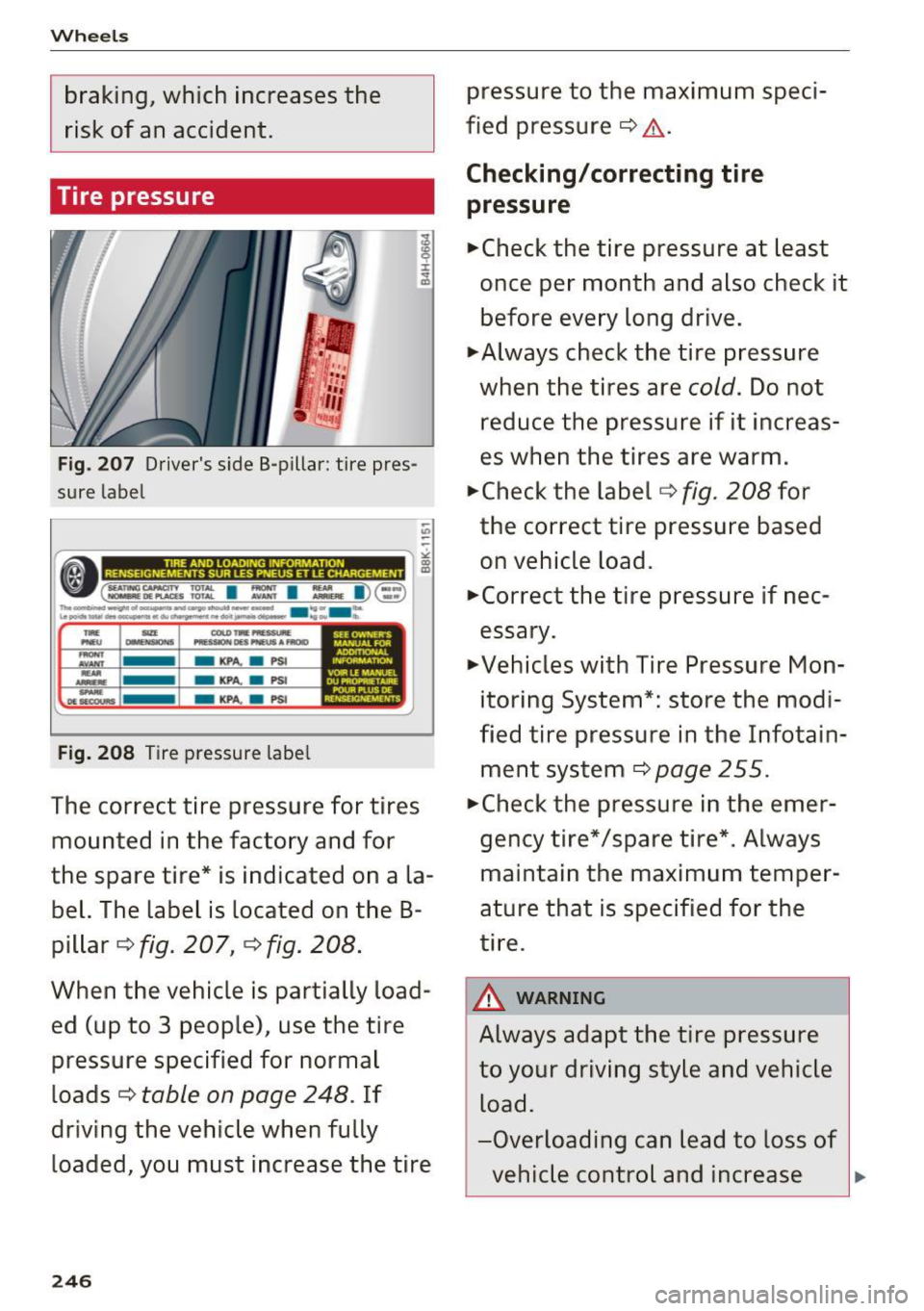
Wheels
braking, which increases the
risk of an accident.
Tire pressure
pressure to the maximum speciĀ
fied pressure
c:::> ,&. .
Checking/correcting tire
pressure
f ā¢Check the tire pressure at least
:r
..; once per month and also check it
Fig. 207 Driver's side B-pillar : tire presĀ
sure label
:;;
-(~. -----~ ,~
( :=~ ~~:: I ~ I :. I)( ::-) n.,_.....,__.o1___.. .. -vo.._.......... ā¢ ... _ ... le~---~--.....,,_.,-'"-,............ ....,, .
lllf """ PNW 07:0lifla.l
-KPA. a PSI
- KPA.
a PSl
- KPA.
a PSl
Fig. 208 Tire pressure label
SEE OWNEJll"S MAMJAI.FOR
AODmOHAI.
INIFOAMATlON
VOOIUMANUEl.
DUNIOl'N:iTA.IRE POUR
P'l. US DE HTS J
The correct tire pressure for tires
mounted in the factory and for
the spare tire* is indicated on a laĀ
bel. The label is located on the BĀ
pillar
c:> fig. 207, c> fig. 208.
When the vehicle is partially loadĀ
ed (up to 3 people), use the tire
pressure specified for normal
loads
c:> table on page 248. If
driving the vehicle when fully loaded, you must increase the tire
246
before every long drive.
ā¢Always check the tire pressure
when the tires are
cold. Do not
reduce the pressure if it increasĀ
es when the tires are warm.
ā¢Check the label
c:> fig. 208 for
the correct tire pressure based
on vehicle load.
ā¢Correct the tire pressure if necĀ
essary.
ā¢Vehicles with Tire Pressure MonĀ
itoring System*: store the modiĀ
fied tire pressure in the InfotainĀ ment system
c:> page 255.
ā¢Check the pressure in the emerĀ
gency tire*/spare tire*. Always
maintain the maximum temperĀ
ature that is specified for the
tire.
A WARNING ~
Always adapt the tire pressure
to your driving style and vehicle load.
-Overloading can lead to loss of
vehicle control and increase
Page 256 of 302
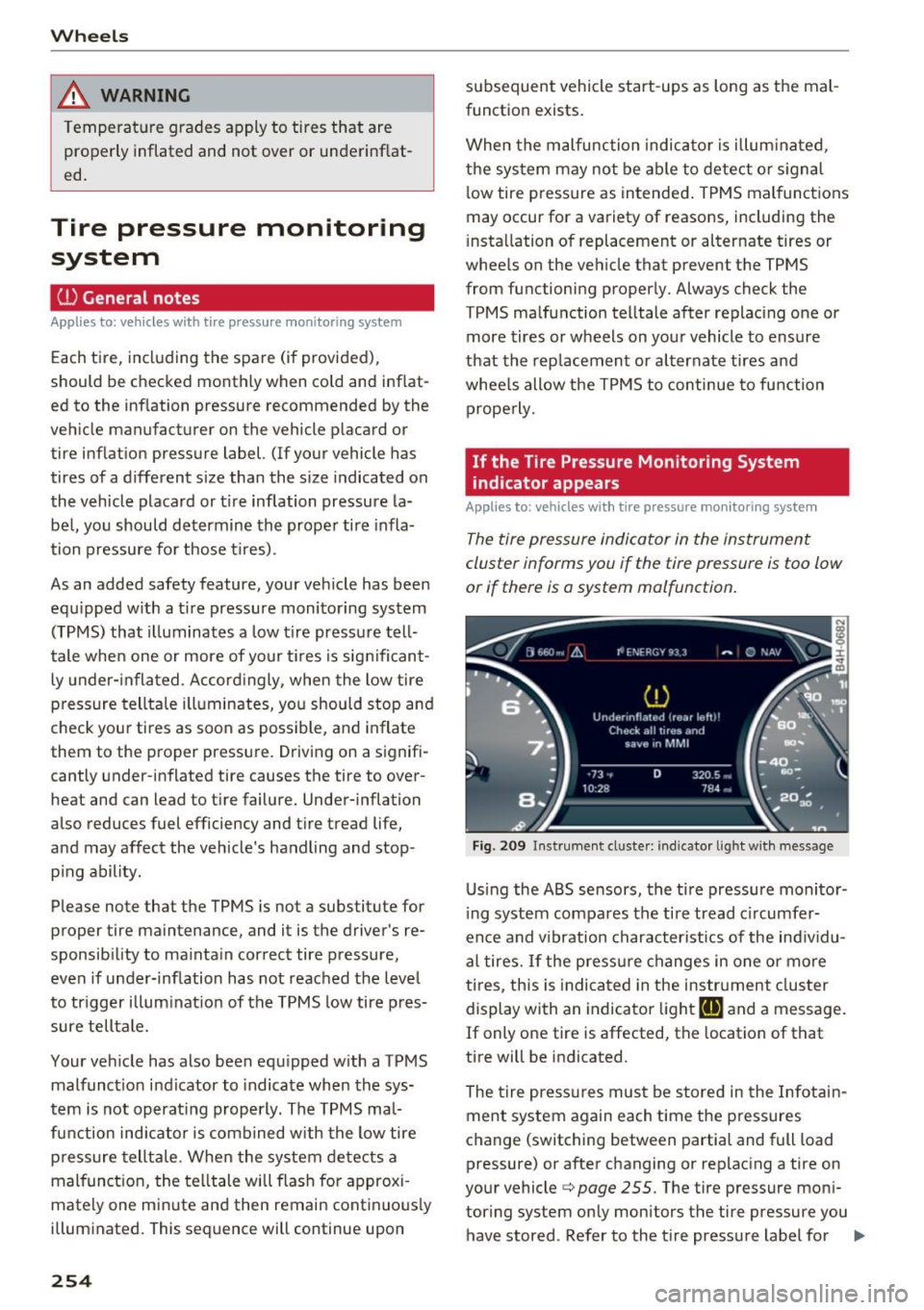
Wheels
_& WARNING
Temperature grades apply to tires that are
properly inflated and not over or underinf lat Ā
ed.
Tire pressure monitoring system
U) General notes
Applies to: vehicles with tire pressure monito ring system
Each tire, including the spare (if provided),
should be checked monthly when cold and inflatĀ
ed to the inflation pressure recommended by the
vehicle manufacturer on the vehicle placard or
tire inflat ion pressure label. (If your vehicle has
tires of a different size than the size indicated on
the vehicle placard or tire inflation pressure laĀ
bel, you should determine the proper tire inflaĀ
tion pressure fo r those tir es) .
As an added safety feature, your vehicle has been
equipped with a t ire pressure monitoring system
(TPMS) that illuminates a low tire pressure tellĀ
tale when one or more of your tires is significantĀ
ly under-inflated . Accord ingly, when the low tire
p ressure telltale illuminates, you should stop and
check your tires as soon as possible, and inflate
them to the proper pressure. Driving on a signifiĀ
cantly under-inflated tire causes the tire to overĀ
heat and can lead to tire failure. Under-inflation
also reduces fuel efficiency and tire tread life,
and may affect the vehicle's handling and stopĀ
ping ability.
Please note that the TPMS is not a substitute for
proper tire maintenance, and it is the driver's reĀ
sponsib ility to maintain correct tire pressure,
even if under-inflation has not reached the level
to trigger illumination of the TPMS low tire presĀ
sure telltale.
Your vehicle has also been equipped with a TPMS
malfunct ion indicator to indicate when the sysĀ
tem is not operating properly. The TPMS malĀ
function indicator is comb ined w ith the low tire
pressure telltale. When the system detects a
malfunction, the telltale will flash for approxiĀ
mately one minute and then remain cont inuous ly
illuminated. This sequence will continue upon
254
subsequent vehicle start-ups as long as the malĀ
function exists.
When the malfunction indicator is illum inated,
the system may not be able to detect or s ignal
low tire pressure as intended . TPMS malfunctions
may occur for a variety of reasons, including the
i nstallation of replacement or alternate tires or
wheels on the vehicle that prevent the TPMS
from functioning properly. Always check the
TPMS malfunction telltale after replacing one or
more tires or wheels on your vehicle to ensure
that the replacement or alternate tires and
whee ls allow the TPMS to continue to function
properly.
If the Tire Pressure Monitoring System
indicator appears
Applies to: vehicles with tire pressure monitoring system
The tire pressure indicator in the instrument
cluster informs you if the tire pressure is too low
or if there is a system malfunction.
Fig . 209 Instrument cl uste r: indicator light with me ssage
Using the ABS sensors, the tire pressure monitorĀ
ing system compares the tire tread c ircumferĀ
ence and v ibration characteristics of the individuĀ
al tires.
If the pressure changes in one or more
ti res, this is ind icated in the instrument cluster
display with an indicator light
[I] and a message.
If only one tire is affected, the locat ion of that
tire will be indicated.
The tire pressures must be stored in the InfotainĀ
ment system again each time the pressures
change (switching between partial and full load
pressure) or after changing or replacing a tire on
your vehicle Ā¢
page 255. The tire pressure moniĀ
tor ing system only monitors the tire pressure you
have stored . Refer to the t ire pressure label for ..,.
Page 259 of 302
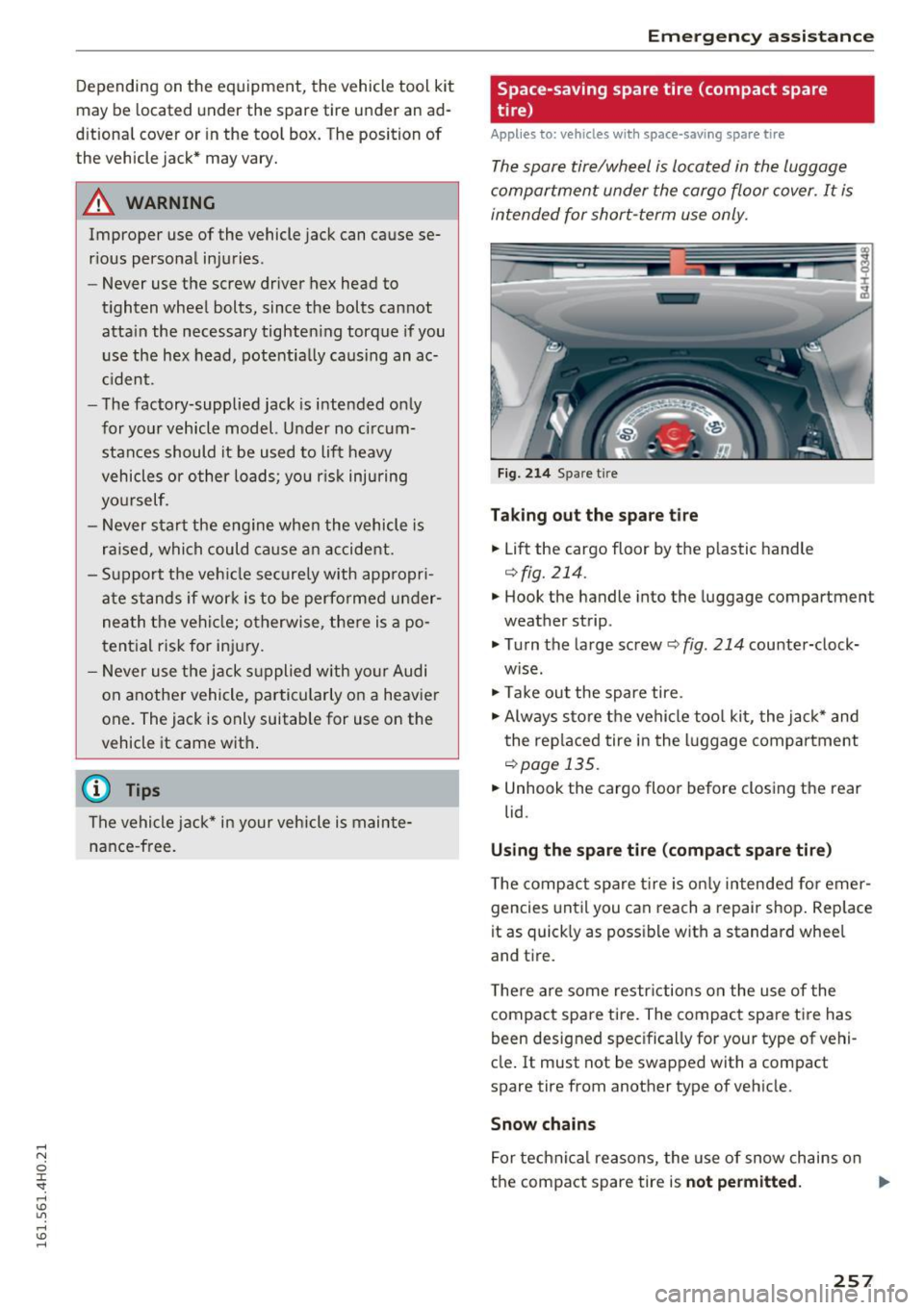
Depending on the equipment, the vehicle tool kit
may be located under the spare tire under an adĀ
d itional cover or in the too l box. The position of
the vehicle jack* may vary.
A WARNING
Improper use of the vehicle jack can cause seĀ
r ious personal injuries.
- Never use the screw driver hex head to
t ighten wheel bolts, since the bolts cannot
attain the necessary tighten ing torque if you
use the hex head, potentia lly causing an acĀ
c ident.
- The factory-supplied jack is intended on ly
for your vehicle model. Under no circumĀ
stances should it be used to lift heavy
vehicles or other loads; yo u risk injuring
yo urself.
- Never start the engine whe n the vehicle is
raise d, which could ca use a n accident.
- Support the veh icle secure ly with appropr iĀ
a te stands if wor k is to be perfo rmed u nder Ā
neath the veh icle; otherwise, the re is a poĀ
tential risk for in jury.
- Never use the jack s upplied with your Audi
on another vehicle, particularly o n a heav ier
one. The jack is only suitab le for use on the
vehicle it came wit h.
@ Tips
The vehicle j ack* in your vehicle is mainte Ā
nance -free.
Em ergen cy a ssis tanc e
Space-saving spare tire (compact spare
tire)
Applies to: vehicles with space-saving spare tire
The spare tire/wheel is located in the luggage
compartment under the cargo floor cover . It is
intended for short-term use only.
Fig . 21 4 Spare tire
Ta king out the spare tir e
... Lift the cargo floor by the p lastic handle
q fig. 214.
.,. Hook the handle into the luggage compartment
weather strip.
.,. Turn the large screw
r:=;, fig . 214 cou nter-clockĀ
w ise.
.,. Take ou t the spare tire.
.,. Always s to re the vehicle too l kit, the jac k* and
the rep laced tire i n the luggage compartment
r:::;, page 135.
.,. Unhook the cargo floor before closing the rear
lid.
Using the spare tire (compact spare tire )
The compact spare tire is on ly intended for emerĀ
gencies until you can reach a repair shop . Rep lace
it as quick ly as poss ible with a standard wheel
and tire.
T here are some restr ictions on the use of the
compact spare tire. The compact spa re tire has
been designed specifically for your type of vehiĀ
cle . It must not be swapped with a compact
spare tire from another type of vehicle.
Snow chains
For technical reasons, the use of snow chains on
the compact spare tire is
not permitted. .,..
257
Page 260 of 302
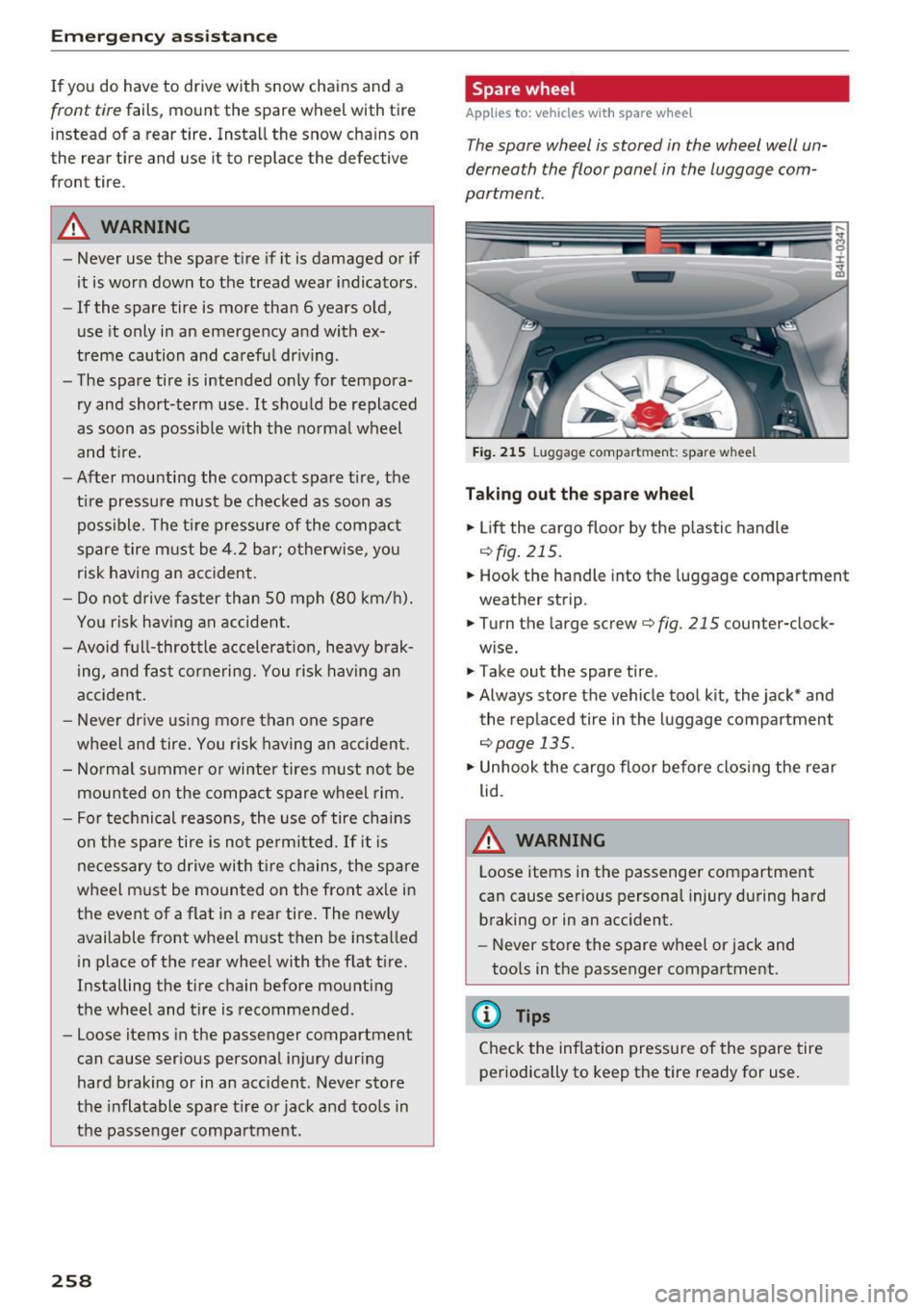
Emerg ency assis ta nce
If you do have to drive with snow chains and a
front tire fails, mount the spare wheel with tire
instead of a rear tire . Install the snow chains on
the rear tire and use it to replace the defective
front tire.
A WARNING
- Never use the spare tire if it is damaged or if
it is worn down to the tread wear indicators.
- If the spare tire is more than 6 years old,
use it only in an emergency and with exĀ
treme caution and ca refu l dr iving .
- The spare tire is intended only for temporaĀ
ry and short-term use . It should be replaced
as soon as possible with the normal wheel
and t ire.
- After mounti ng the compact spare t ire, the
tire pressure must be checked as soon as possible. The tire pressure of the compac t
spare tire must be 4.2 bar; otherwise, you risk having an accident.
- Do not drive faster than SO mph (80 km/h).
Yo u risk hav ing an accident.
- Avoid full-throttle accelerat ion, heavy brakĀ
ing, and fast cornering. You risk having an
acc ident .
- Never dr ive using more than one spare
wheel and tire. You risk having an acciden t.
- Normal summer or winter tires must not be
mounted on the compact spare wheel rim.
- For technical reasons, the use of tire chains
on the spare tire is not pe rm itted. If it is
necessary to drive with tire chains, the spare
wheel m ust be mounted on the front ax le in
the event of a flat in a rear tire. The new ly
available front wheel must then be insta lled
in place of the rear wheel with the flat t ire.
Installing the tire chain before mounting
the wheel and t ire is recommended.
- Loose items in the passenger compartment
can cause ser ious personal injury during
hard braking or in an accident. Never store
the inflatable spare t ire or jack and too ls in
the passenger compartment.
258
Spare wheel
Applies to: vehicles with spare whee l
The spore wheel is stored in the wheel well unĀ
derneath the floor panel in the luggage
comĀ
portment.
Fig . 215 Luggage compartmen t: spare whee l
Taking out th e spar e wh eel
.. Lift the cargo floor by the plastic handle
Ā¢ fig. 215.
.. Hook the handle into the luggage compartment
weather strip.
.. Turn the large screw
Ā¢fig. 215 counter-clockĀ
wise .
.,. Take out the spare tire.
.,. Always store the vehicle tool kit , the jack* and
the rep laced tire in the luggage compartment
Ā¢page 135.
.. Unhook the cargo floo r before clos ing the rear
lid.
A WARNING
Loose items in the passenger compartment
can cause serious personal injury during hard braking or in an acc ident.
- Never store the spare wheel or jack and
too ls in the passenger compartment .
(D Tips
Check the inflation pressure of the spare tire
periodically to keep the tire ready for use.
-
Page 261 of 302
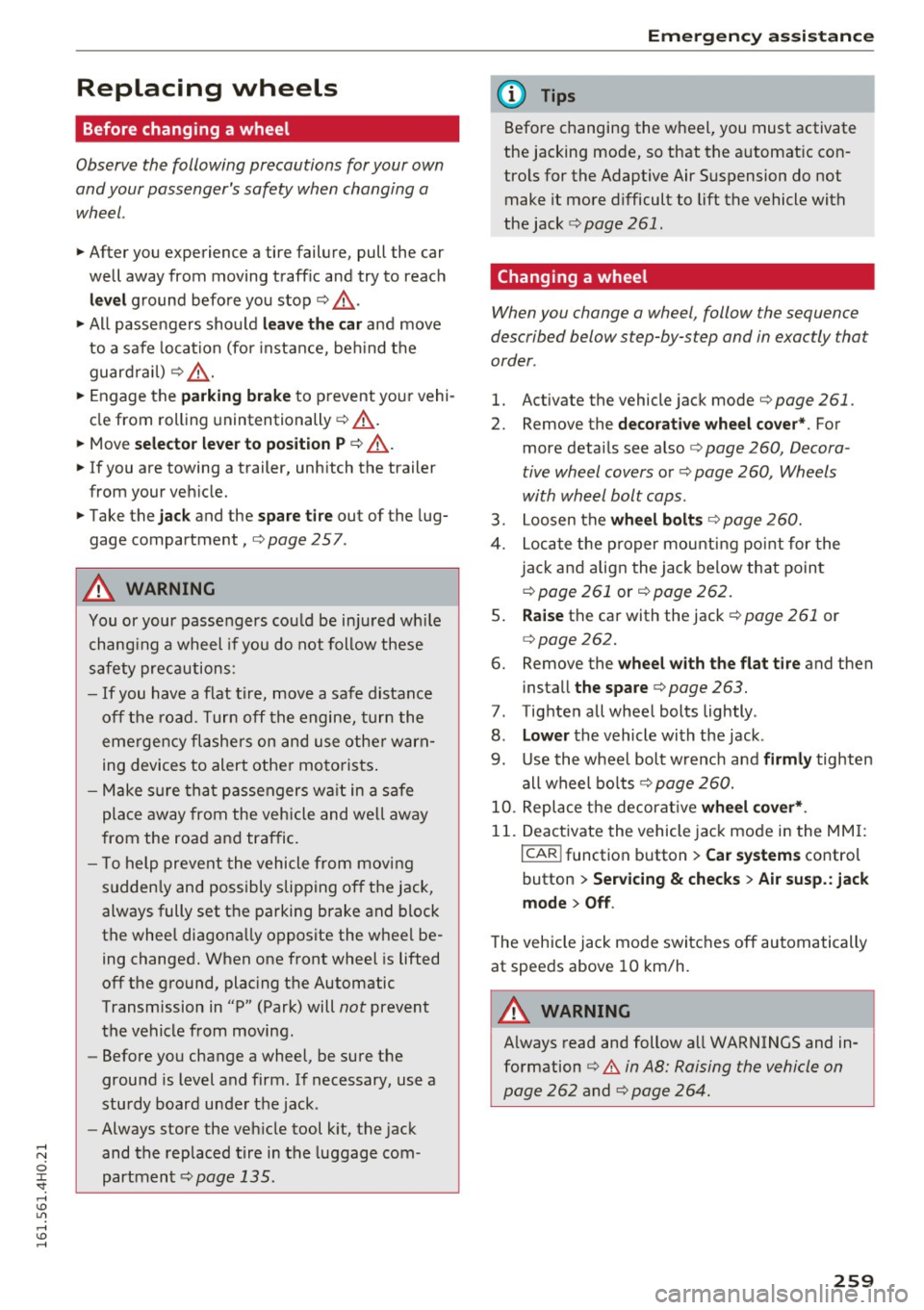
Replacing wheels
Before changing a wheel
Observe the following precautions for your own
and your passenger's safety when changing a
wheel.
.,. After you experience a tire failure, pull the car
well away from moving traffic and try to reach
level ground before you stopĀ¢.,&. .
.. All passengers should
leave the car and move
to a safe location (for instance, beh ind the
guardrail) Ā¢.,&. .
.,. Engage the
parking brake to prevent your vehiĀ
cle from rolling unintentionally Ā¢.,&. .
.. Move
selector lever to position P Ā¢ .,&. .
1> lfyou are towing a trailer, unhitch the trailer
from your vehicle.
.,. Take the
jack and the spare tire out of the lugĀ
gage compartment,
Ā¢page 257.
..&, WARNING
You or your passengers could be injured wh ile
changing a wheel if you do not follow these
safety precautions:
- If you have a flat tire, move a safe distance
off the road. Turn off the engine, turn the
emergency flashers on and use other warnĀ
ing devices to alert other motorists.
- Make sure that passengers wa it in a safe
place away from the vehicle and well away
from the road and traffic.
- T o help prevent the vehicle from moving
sudden ly and possibly slipping off the jack,
always fully set the parking brake and block
the wheel diagonally opposite the wheel beĀ
ing changed. When one front wheel is lifted
off the ground, plac ing the Automatic
Transmission in "P" (Park) will
not prevent
the vehicle from moving.
- Before you change a wheel, be sure the
ground is level and firm . If necessary, use a
sturdy board under the jack .
- Always store the vehicle tool k it, the jack
and the replaced tire in the luggage comĀ
partment Ā¢
page 135.
Emergency assistance
{!) Tips
Before changing the wheel, you must activate
the jacking mode, so that the automat ic conĀ
tro ls for the Adaptive Air Suspension do not
make it more difficult to lift the vehicle with
the jack Ā¢
page 261 .
Changing a wheel
When you change a wheel , follow the sequence
described below step-by-s tep and in exactly tha t
order .
l. Activate the vehicle jack mode Ā¢ page 261 .
2. Remove the decorative wheel cover*. For
more details see alsoĀ¢
page 260, Decora Ā
tive wheel covers
orĀ¢ page 260, Wheels
with wheel bolt caps .
3. Loosen the wheel boltsĀ¢ page 260.
4. Locate the proper mounting point for the
jack and align the jack below that point
Ā¢ page 261 orĀ¢ page 262.
5. Raise the car with the jackĀ¢ page 261 or
Ā¢page 262.
6. Remove the wheel with the flat tire and then
install
the spare Ā¢ page 263.
7. Tighten all wheel bolts lightly .
8.
Lower the vehicle with the jack .
9. Use the wheel bolt wrench and
firmly tighten
all wheel bolts<=>
page 260.
10. Replace the decorative wheel cover*.
11. Deactivate the vehicle jack mode in the MMI :
I CAR! function button > Car systems contro l
button
> Servicing & checks > Air susp.: jack
mode > Off.
The vehicle jack mode switches off automatically
at speeds above 10 km/h .
..&, WARNING
Always read and follow all WARNINGS and inĀ
formation
Ā¢ .&. in AB: Raising the vehicle on
page 262
and Ā¢ page 264.
259
Page 262 of 302
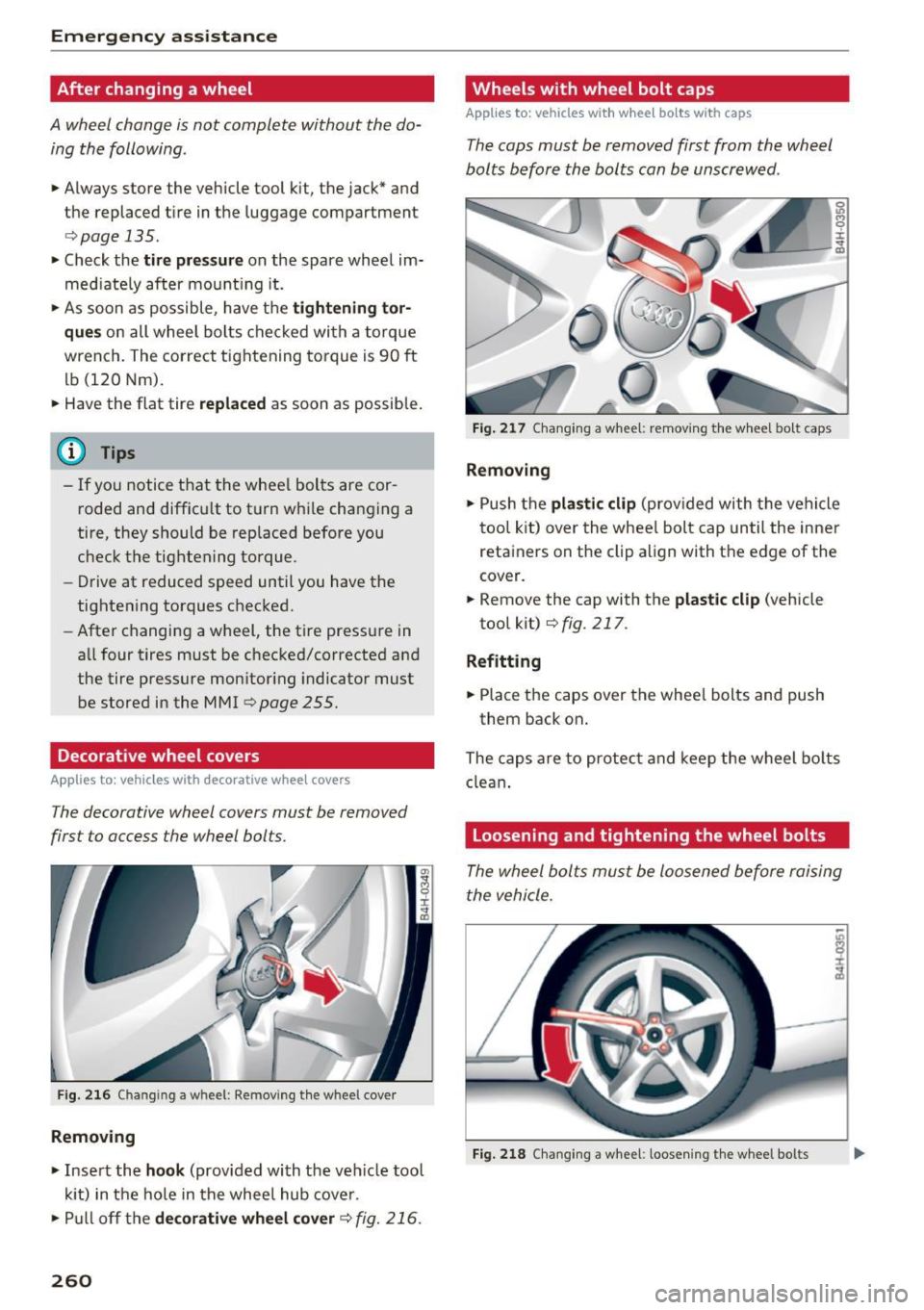
Emergency assistance
After changing a wheel
A wheel change is not complete without the doĀ
ing the following .
ā¢ Always store the vehicle tool kit, the jack* and
the replaced tire in the luggage compartment
<=>page 135.
ā¢ Check the tire pressure on the spare wheel imĀ
mediate ly after mounting it.
ā¢ As soon as possible, have the
tightening torĀ
ques
on all wheel bolts checked with a torque
wrench. The correct tightening torque is 90 ft
lb (120 Nm).
ā¢ Have the flat tire
replaced as soon as possible.
@ Tips
- If you notice that the whee l bolts are corĀ
roded and difficu lt to turn while changing a
tire, they should be replaced before you
check the tightening torque .
- Drive at reduced speed until you have the
tightening torques checked.
- After changing a wheel, the tire pressure in
a ll four tires must be checked/corrected and
the tire pressure mon itor ing indicator must
be stored in the MMI
c> page 255.
Decorative wheel covers
App lies to: vehicles with decorative wheel covers
The decorative wheel covers must be removed
first to access the wheel bolts .
Fig. 216 Chan gin g a w heel : Removing the whee l cover
Removing
ā¢ Insert the hook (provided with the ve hicle tool
kit) in the hole in the wheel hub cover.
ā¢ Pull off the
decorative wheel cover c> fig. 216.
260
Wheels with wheel bolt caps
Applies to: vehicles with wheel bo lts with caps
The caps must be removed first from the wheel
bolts before the bolts can be unscrewed .
Fig. 217 Changing a wheel: removing the wheel bo lt caps
Removing
ā¢ Push the plastic clip (provided with the vehicle
tool kit) over the whee l bolt cap until the inner
retainers on the clip align with the edge of the
cover.
ā¢ Remove the cap with the
plastic clip (vehicle
tool kit)
<=> fig. 217 .
Refitting
ā¢ Place the caps over the wheel bolts and push
them back on .
The caps are to protect and keep the wheel bolts
clean.
Loosening and tightening the wheel bolts
The wheel bolts must be loosened before raising
the vehicle.
Fig. 218 Chang ing a wheel: loosening the wheel bo lts
Page 265 of 302
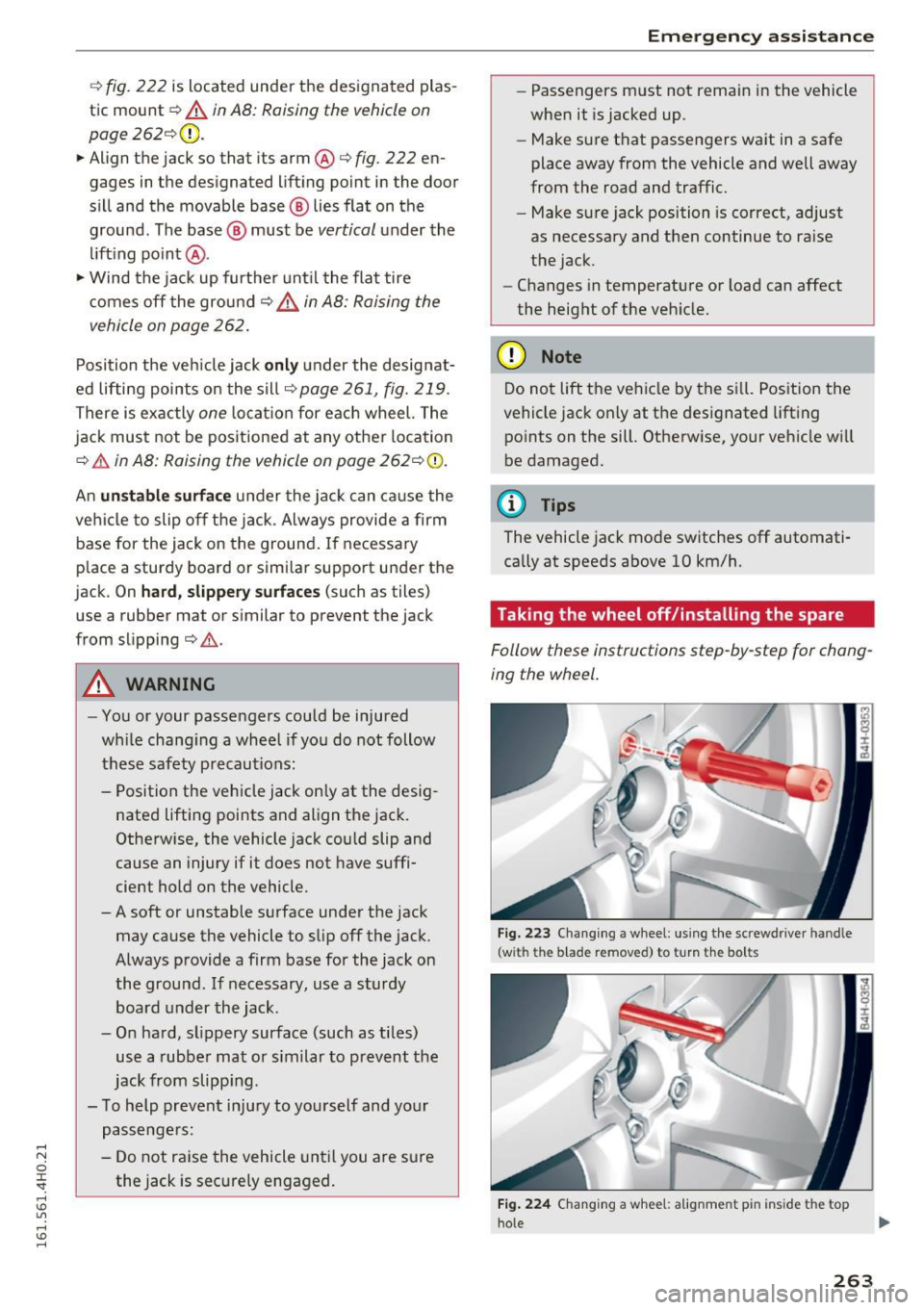
c::> fig. 222 is located under the designated plasĀ
tic mount
c::> A in AB: Raising the vehicle on
page
262 <=:>(D.
.. Align the jack so that its armĀ®
c::> fig. 222 enĀ
gages in the designated lifting point in the door
sill and the movable base Ā® lies flat on the
ground . The base Ā® must be
vertical under the
li ft ing po int @ .
.,. Wind the jack up further unt il the fla t tire
c omes off the ground
c::> A in AB: Raising the
vehicle on page
262.
Position the veh icle jack
onl y under the designatĀ
ed lifting points on the sill
<=:>page 261, fig. 219 .
There is exactly one locatio n for each wheel. The
jack must not be positioned at any other location
c::> .&. in AB: Raising the vehicle on page 262<=:> 0.
An
un stabl e surface under the jac k can ca use the
vehi cle to slip off the jack . Always provide a firm
base for the jack on the ground. If necessary
p lace a sturdy board or similar support under the
jack. On
hard , slippery surfaces (such as tiles)
use a rubber mat or similar to prevent the jack
from slipping
c::> .&. .
A WARNING
-
-You or your passengers could be injured
wh ile chang ing a wheel if you do not follow
these safety precautions :
- Position the vehicle jack only at the desig Ā
nated lifting points and align the jack.
Otherw ise, the vehicle jack cou ld slip and
cause an injury if it does not have suffiĀ
cient hold on the vehicle.
- A soft or unstable surface under the jack
may cause the vehicle to slip off the jack.
Always provide a firm base for the jack on
the ground .
If necessary, use a sturdy
board under the jack.
- O n hard, s lippery surface (such as tiles)
use a rubber mat or s imilar to prevent the
jack from slipp ing.
- To help prevent inju ry to yourself and your
passenge rs:
- Do not raise the vehicle unt il you are sure
the jack is secure ly engaged .
Emergen cy a ssis tanc e
-Passengers must not remain in the vehicle
when it is jacked up.
- Make sure that passengers wait in a safe
place away from the vehicle and well away
from the road and traffic.
- Make sure jack position is correct, adjust
as necessary and then continue to raise
the jack .
- Changes in temperature or load can affect
the height of the veh icle.
(D Note
Do not lift the vehicle by the si ll. Position the
vehicle jack on ly at the designated lift ing
points on the sill. Otherwise, your veh icle w ill
be damaged.
@ Tips
The vehicle jack mode switches off automatiĀ
cally at speeds
above 10 km/h.
Taking the wheel off/installing the spare
Follow these instructions step-by-step for changĀ
ing the wheel .
Fig . 223 Cha ngin g a w heel: us ing the screwdriver handle
(wit h the b lade removed) to turn th e bolts
Fig. 224 Changing a w hee l: a lig nment p in in side the top
hole
263
Page 266 of 302
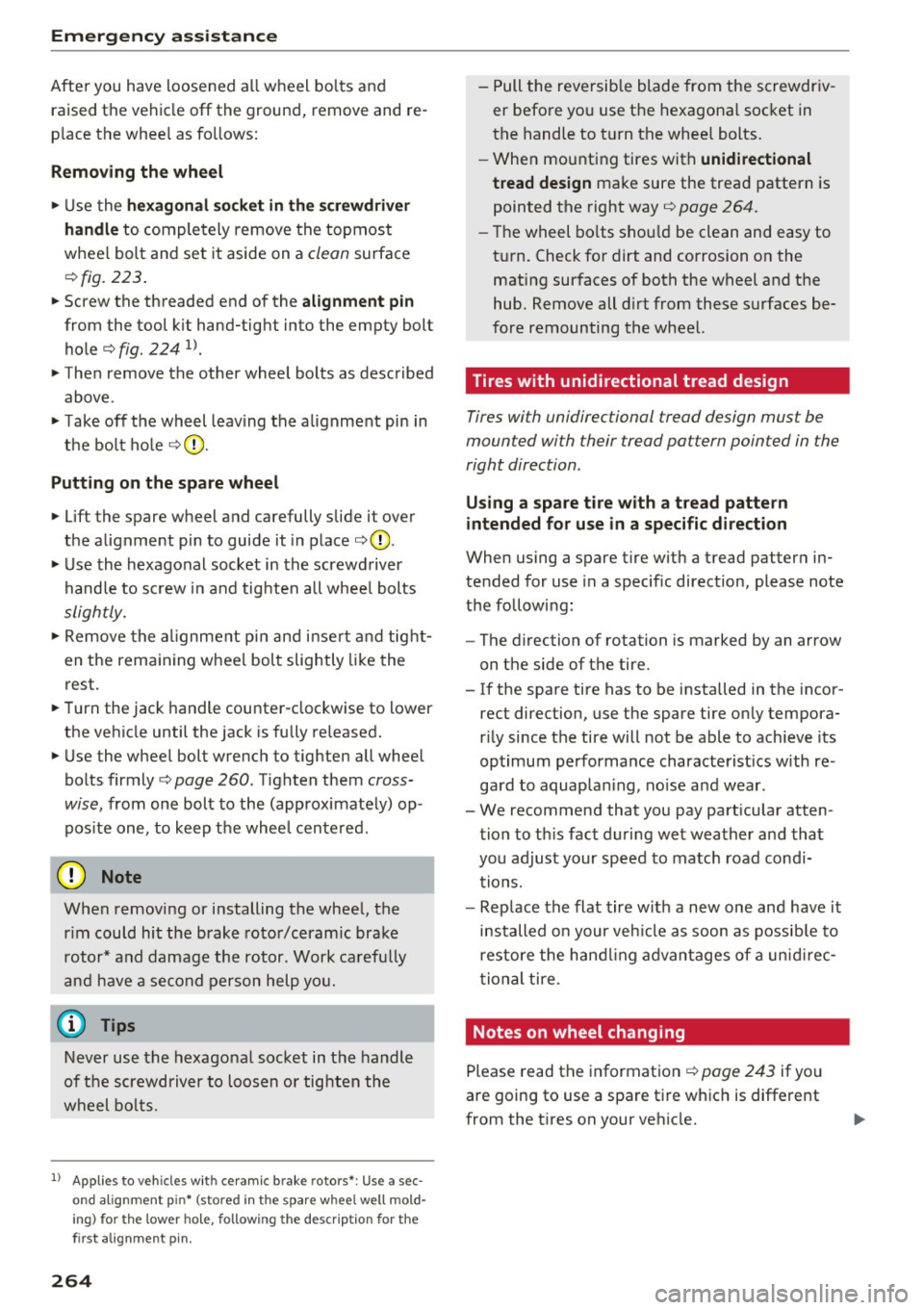
Emergency assistance
After you have loosened all wheel bolts and raised the vehicle off the ground, remove and reĀ
place the wheel as follows:
Removing the wheel
.,. Use the hexagonal socket in the screwdriver
handle
to completely remove the topmost
wheel bolt and set it aside on a
clean surface
.::!> fig. 223.
.,. Screw the threaded end of the alignment pin
from the tool kit hand-tight into the empty bolt
holeĀ¢
fig. 224 1> .
.,. Then remove the other wheel bolts as described
above.
.,. Take off the wheel leaving the alignment pin in
the bolt hole Ā¢0 .
Putting on the spare wheel
.,. Lift the spare wheel and carefully slide it over
the alignment pin to guide it in place Ā¢0 .
.,. Use the hexagonal socket in the screwdriver
handle to screw in and tighten all wheel bolts
slightly .
.,. Remove the alignment pin and insert and tightĀ
en the remaining wheel bolt slightly like the
rest.
.,. Turn the jack handle counter-clockwise to lower
the vehicle until the jack is fully released.
.,. Use the wheel bolt wrench to tighten all wheel
bolts firmly Ā¢
page 260 . Tighten them crossĀ
wise,
from one bolt to the (approximately) opĀ
posite one, to keep the wheel centered.
0 Note
When removing or installing the wheel, the
rim could hit the brake rotor/ceramic brake
rotor* and damage the rotor . Work carefully
and have a second person help you.
Never use the hexagonal socket in the handle
of the screwdriver to loosen or tighten the
wheel bolts.
1
> A pp lies to vehicles with cer amic brake rotors*: Use a secĀ
o n d alignment p in* (sto re d in th e s pare w hee l well mold Ā
in g) fo r the lower hole , fol low ing the descrip tion for the
fir st a lig nme nt pin .
264
-Pull the reversible blade from the screwdrivĀ
er before you use the hexagonal socket in
the handle to turn the wheel bolts.
- When mounting tires with
unidirectional
tread design
make sure the tread pattern is
pointed the right wayĀ¢
page 264.
-The wheel bolts should be clean and easy to
turn. Check for dirt and corrosion on the
mating surfaces of both the wheel and the
hub. Remove all dirt from these surfaces beĀ
fore remounting the wheel.
Tires with unidirectional tread design
Tires with unidirectional tread design mus t be
mounted with their tread pattern pointed in the
right direction .
Using a spare tire with a tread pattern
intended for use in a specific direction
When using a spare tire with a tread pattern inĀ
tended for use in a specific direction, please note
the following:
- The direction of rotation is marked by an arrow
on the side of the tire.
- If the spare tire has to be installed in the incorĀ
rect direction, use the spare tire only temporaĀ
rily since the tire will not be able to achieve its
optimum performance characteristics with reĀ
gard to aquaplaning, noise and wear.
- We recommend that you pay particular atten Ā
tion to this fact during wet weather and that
you adjust your speed to match road condiĀ tions.
- Replace the flat tire with a new one and have it
installed on your vehicle as soon as possible to
restore the handling advantages of a unidirecĀ
tional tire.
Notes on wheel changing
Please read the informationĀ¢ page 243 if you
are going to use a spare tire which is different
from the tires on your vehicle.